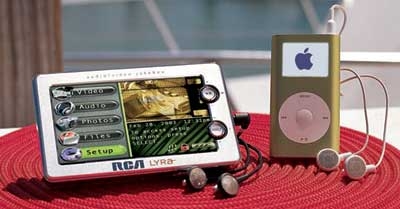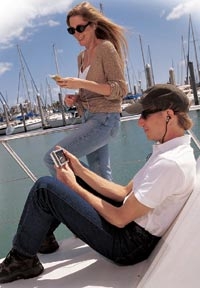e-Life on the Go Page 4
Day Three: Marina at Key BiscayneWe were ready for a three-hour tour of Biscayne Bay, said by some to be the best sailing bay in the world. But we needed a few tunes for the trip - or if we happened to get shipwrecked, we might need a thousand songs. Of course, our library would have to fit in a beach bag or, better yet, a back pocket.  RCA Lyra A/V jukebox and iPod mini music player.
RCA Lyra A/V jukebox and iPod mini music player.
The Apple iPod mini music player was perfect. This slim package - about two-thirds the size of the original iPod - holds a 4-GB hard drive, and at a reasonable compression rate of 128 kilobits per second (kbps), it can store 70 hours of music, or 1,000 songs. It can decode AAC, MP3, WAV, and AIFF files. Last but not least, its anodized aluminum body comes in five delicious colors, including key-lime green.
 To load the iPod mini, we made a FireWire connection with the Toshiba notebook (you can use USB 2.0, too) and used the iTunes software to simply drag and drop files. We also used the Auto Sync function, so any new music we loaded into iTunes was automatically transferred to the iPod every time it was connected. (We also could have downloaded music purchased from the iTunes Music Store.)
To load the iPod mini, we made a FireWire connection with the Toshiba notebook (you can use USB 2.0, too) and used the iTunes software to simply drag and drop files. We also used the Auto Sync function, so any new music we loaded into iTunes was automatically transferred to the iPod every time it was connected. (We also could have downloaded music purchased from the iTunes Music Store.)
Operating the iPod mini is so easy even a drunken sailor could do it. Just scroll through the menu to find an album or song, and hit play. The way-cool click wheel makes navigating easy even as you bounce over the waves. You can sort by artist, album, song, or genre. Songs are assigned to genres by the CDDB database online, but you can customize them. We had some Emerson, Lake & Palmer that was properly placed in the Classic Rock category, and Alanis Morissette went into Alternative. But it put Metallica into Rock - we moved those tracks to Metal. You can easily create an on-the-go playlist or test your knowledge of your collection with a music quiz. There was even a calendar and alarm to remind us when it was time for more sunscreen. We also appreciated the 8-hour battery life.
On the way to and from the marina, we auditioned our music collection over the car radio by using Griffin Technology's iTrip to transmit from the iPod mini to an unused FM broadcast frequency. Of course, you can do the same thing with a home radio or music system, too. And unlike most transmitters for portable players, the chic little iTrip plugs right into the top of the iPod, eliminating unfashionable wires.
Sailing the ocean blue, with a seascape horizon all around, makes you think of one thing, and that's the possibility of sinking. To distract us from that notion, we powered up the RCA Lyra RD2780 A/V Jukebox. This handheld movie theater has a 3 1/2-inch LCD screen with 320 x 240 resolution. And its 20-GB hard drive can store up to 80 hours of video loaded from a PC at a bit rate of 480 kbps, or 40 hours when transferred directly from a video source.The video quality on the small screen is acceptable for casual entertainment on a boat ride, but don't expect it to rival your plasma TV. The jukebox has composite-video and stereo audio inputs and outputs and observes analog copyright protection.
Alternatively, you can store 600 hours of MP3 music at 128 kbps or about 50,000 JPEG photos at 300 kilobytes per file. The onboard MPEG-4, MPEG-1, MP3, and WMA decoders do the honors. The Jukebox also sports a Type-1 CompactFlash slot, which makes it easy to move any kind of file to the internal hard drive, or you can use the USB 2.0 port. The Lyra's menu makes navigating the contents a breeze, and the graphical interface can be customized to your preferences. Movie mode provides a respectable 4 hours of battery life, but we wished for more.
You can also use the Lyra as a digital picture frame to show endless slideshows of vacation photos. You can even prop it up with the built-in kickstand. After our voyage, we propped ourselves against the bar and wetted our whistles back on dry land, greatly relieved that it wasn't women and children first. PDF: Fast Facts
- Log in or register to post comments



































































